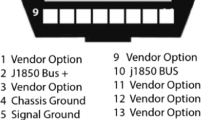Abstract
Predicting the next movement directions, which will be chosen by the vehicle driver at each junction of a road network, can be used largely in VANET (Vehicular Ad-Hoc Network) applications. The current methods are based on GPS. In a number of VANET applications the GPS service is faced with some obstacles such as high-rise buildings, tunnels, and trees. In this paper, a GPS-free method is proposed to predict the vehicle future movement direction. In this method, vehicle motion paths are described by using the sequence of turning directions on the junctions, and the distances between the junctions. Movement patterns of the vehicles are extracted through clustering of the vehicle’s motion paths using SOM (Self Organizing Map). These patterns are then used for predicting the next movement direction, which will be chosen by the driver at the next junction. The obtained results indicate that our GPS-free method is comparable with the GPS-based methods, while having more advantages in different applications regarding urban traffic.
Similar content being viewed by others
References
Andreone L, Ricerche C (2005) Activities and applications of the vehicle to vehicle and vehicle to infrastructure communication to enhance road safety. In: 5th European congress and exhibition on ITS. doi:10.1145/1329125.1329346
Morris R, Jannotti J, Kaashoek F, Li J, Decouto D (2000) CarNet: a scalable ad hoc wireless network system. In: Proceedings of the 9th ACM SIGOPS European workshop, pp 61–65
Feng J, Zhu Y, Mukai N, Watanabe T (2007) Search on transportation networks for location-based service. Appl Intell 26(1):69–79. doi:10.1007/s10489-006-0004-4
Hartenstein H, Laberteaux P (2008) A tutorial survey on vehicular ad hoc networks. IEEE Commun Mag 46(6):164–171. doi:10.1109/MCOM.2008.4539481
Froehlich J, Krumm J (2008) Route prediction from trip observations. In: Society of automotive engineers (SAE) 2008 World congress. doi:10.4271/2008-01-0201
Kaplan F, Elliott D (2006) Understanding GPS: principles and applications, 2nd edn. Artech House, Norwood. doi:10.1017/S0373463300023730
Wellenhof H, Lichtenegger BH, Collins B (1994) GPS: theory and practice, 3rd edn. Springer, New York. doi:10.1016/S0969-6997(99)00021-6
Humphreys T, Ledvina BM, Psiaki ML, Hanlon BW, Kintner PM (2008) Assessing the spoofing threat: development of a portable GPS civilian spoofer. In: Proc of ION GNSS 2008, Institute of Navigation, Savannah, GA
Montgomery PY, Humphreys TE, Ledvina BM (2009) A multi-antenna defense: receiver-autonomous GPS spoofing detection. Inside GNSS 4(2):40–46
Doan P, Kawai M (2009) Improved GPS-free ad-hoc network positioning for urban disaster response. In: Proc of urban cultural heritage disaster mitigation, vol 3(1), pp 91–98. doi:10.1155/2010/692513
Capkun S, Hamdi M, Hubeaux J (2002) GPS-free positioning in mobile ad-hoc networks. Cluster Comput 5(2):57–67. doi:10.1.1.18.9834
Iyengar R, Sikdar B (2003) Scalable and distributed GPS free positioning for sensor networks. In: Proc IEEE conf comm ICC 2003, vol 1(1), pp 338–342. doi:10.1.1.2.4979
Caruso A, Chessa A, De S, Urpi S (2005) A GPS free coordinate assignment and routing in wireless sensor networks. In: Proc 24th annual joint conf IEEE computer and communications societies INFOCOM 2005, pp 150–160. doi:10.1.1.101.1210
Bahadori S, Leone G, Nardi D, Scozzafava L (2007) Real-time people localization and tracking through fixed stereo vision. Appl Intell 26(2):83–97. doi:10.1007/s10489-006-0013-3
Krumm J (2006) Real time destination prediction based on efficient routes. In: Society of automotive engineers (SAE) 2006 World congress. doi:10.1.1.153.2972
Simmons R et al (2006) Learning to predict driver route and destination intent. In: 2006 IEEE intelligent transportation systems conference, Toronto, Canada, pp 127–132. doi:10.1.1.169.8237
Krumm J (2008) A Markov model for driver turn prediction. In: Society of automotive engineers (SAE) 2008 World congress. doi:10.1.1.153.2524
Kohonen T (1990) The self-organizing map. Proc IEEE 78(9):45–52. doi:10.1029/2004JC002786
Freeman J, Skapura D (1991) Neural network, algorithms, applications and programming techniques. Addison-Wesley, Reading. doi:10.1016/S1461-5347(98)00055-8
Sankar P, Biswarup D, Pabitra M (2004) Rough self organizing map. Appl Intell 21(3):289–299. doi:10.1023/B:APIN.0000043561.99513.69
Ye H, Lo B (2000) Feature competitive algorithm for dimension reduction of the self-organizing map input space. Appl Intell 13(3):215–230. doi:10.1023/A:1026511926034
Vesanto J, Alhoniemi E (2000) Clustering of self organized map. IEEE Trans Neural Netw 11(3):586–600. doi:10.1109/72.846731
Schalkoff R (1997) Artificial neural networks. McGraw-Hill, New York. doi:10.1205/fbp.04205
Author information
Authors and Affiliations
Corresponding author
Rights and permissions
About this article
Cite this article
Bohlooli, A., Jamshidi, K. A GPS-free method for vehicle future movement directions prediction using SOM for VANET. Appl Intell 36, 685–697 (2012). https://doi.org/10.1007/s10489-011-0289-9
Published:
Issue Date:
DOI: https://doi.org/10.1007/s10489-011-0289-9




